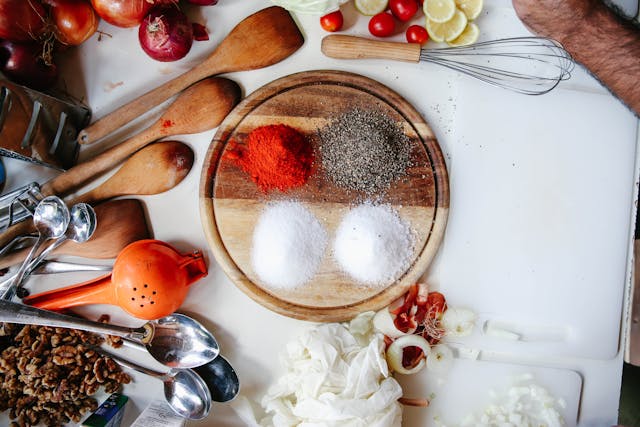Food preservatives have been used since ancient times and salt is the most common ingredient in traditional food preservation methods. In today’s world, we have developed new techniques to preserve food. We feel it’s essential to look into how we can utilize preservatives to promote food safety and freshness while also reducing food waste, as sustainability and food waste reduction become more and more significant aspects of our food systems. The ability to preserve food using both modern and traditional methods allows us to enjoy a variety of cuisines. Let’s study the food preservatives we use to preserve the safety, freshness, and shelf life of our food.
What Are Food Preservatives?
Substances that stop microbiological development in food are known as food preservatives. Food preservatives extend the shelf life of food and help in limiting bacterial development. Preservatives can be found in processed, packaged foods such as bread, crackers, cereals, snacks, ready-to-eat meals, cheese, yogurt, deli meats, sauces, and soups.

What are food preservatives give an example?
Natural sources of preservatives include vinegar, sugar, salt, and citrus juice. There are also artificial or synthetic preservatives. Food preservatives examples are Potassium Nitrate, Calcium Sorbate,
Benzoic acid, Erythorbic Acid, Sodium Benzoate.
Antioxidants also used as preservatives such as Butylated Hydroxyanisole (BHA), Butylated Hydroxytoluene (BHT), Ascorbyl Palmitate
What are types of preservatives?
Preservatives come in two different types: natural and synthetic/chemical.
Antimicrobial: Stops the growth of bacteria, fungus, and other germs.
Antioxidants: Reduce the rate of oxidation or stop it completely.
Enzymes: Prevent cosmetics and similar goods from expiring.
What are natural preservatives for food?
The main purpose of natural preservatives in food and drink products is to slow down spoilage and maintain the item’s flavour and color. They can also be found in other hygiene items and cosmetics, though. Some examples of natural preservatives are as follows:
- Sugar
- Sodium salt
- Lemon juice
- Rosemary Extract
- Citric acid
- Sorbic acid

Chemical food preservatives
Man-made chemicals known as artificial or chemical preservatives are applied to a wide range of food items to increase their shelf life. They are also used to keep food fresh longer and preserve its color and texture. Some chemical food preservatives examples are:
- Propionates
- Sorbates
- Sulfites
- Antioxidants
- Benzoates
- Antimicrobial agents
- Chelating agents
- Nitrates

How food preservatives work?
Three broad categories of preservatives can be distinguished:
Antimicrobials: which inhibit the growth of bacteria, molds, or yeasts
Antioxidants: which delay the oxidation of fats and lipids that cause rancidity
Enzymes: a third category, which inhibits enzymes that encourage the ripening process that naturally takes place after fruits and vegetables are harvested.
Sulfur dioxide is a chemical present in many foods and belongs to a wider group called sulfites. It functions in all three categories. Sulfites prevent the growth of microorganisms by interfering with their cells’ regular functions. Sulfite allergies affect a tiny percentage of people, although most people are safe to use the preservative, according to the FDA. Sulfites are present in some fruit juices, vinegar, and dried fruits.
Propionates are antimicrobials that contribute to the freshness of baked goods. Natural sources of propionic acid include cheese, apples, strawberries, and cereals. It functions against bacterium spores that cause “rope,” a condition that makes bread unsafe for consumption, as well as bread molds.
Another weak antibacterial that combats fungi is benzoate; it functions best in low-acid environments with few bacteria. Cranberries naturally contain benzoates.
Nitrates and nitrites are used to inhibit harmful botulism bacteria in meat and preserve foods. The fresh pink color of cured beef is also a result of these preservatives. Meat turns brown in the absence of nitrates or nitrites. The only possible issue with nitrites is that they can combine with amino acids to create nitrosamines, which are substances that might cause cancer. But the levels used in cured beef are low and not to be concerned about.
When food products are exposed to air, antioxidant preservatives prevent the chemical deterioration of the food. Oils and lipids containing unsaturated fatty acids are particularly prone to oxidation, which results in a rotten taste and smell.
A third category of preservatives targets food enzymes that lead to postharvest over-ripening of fruits and vegetables. For example, one enzyme quickly turns apples and potatoes brown when they are sliced or peeled. Ascorbic acid (vitamin C) and citric acid are examples of acids that hinder this activity by lowering the enzyme’s pH level too low.
What preservatives are safe to eat?
Preservatives made of natural ingredients are increasingly becoming considered safer and superior than artificial ones. Unlike artificial preservatives, these plant-based preservatives don’t have any unfavorable side effects.
Natural preservatives have been used for a very long period. Long-term storage of meats, fruits, and vegetables is possible with the help of these preservatives. Preservatives now can enhance taste and nutrition. In addition to adding color, natural preservatives also lower the cost of food.
Natural preservatives provide food with vitamins and minerals, which are the source of nutrients. Foods are enhanced and fortified by the higher nutritious content.
There are other advantages to adding preservatives, such as less food waste. Increasing the shelf life of food increases the options available to those who face food insecurity. For the most part, both natural and artificial preservatives contribute to a stable food supply.
What preservatives are used in frozen food?
Since food doesn’t grow microbes at temperatures below −9.5 °C (15 °F), frozen foods naturally have an acceptable level of protection against food deterioration. Food preservation over extended periods of time may require even lower temperatures for food storage. Regularly added to frozen food, carboxymethylcellulose (CMC) is a flavourless and dull stabilizer that doesn’t compromise the quality of the meal.

Advantages and disadvantages of food preservatives
Preservatives help preserve the quality and safety of food products by providing several benefits for food preservation. Here are a few main advantages:
- Extended shelf life
- Prevention of microbial spoilage
- Retention of nutritional value
- Maintaining freshness and flavor
- Cost-Effective
- Convenience
- Consistency in the quality of food
- Global distribution of food products
An increasing number of consumers are interested in clean-label products, which are defined by a low usage of artificial additives, such as preservatives.
To satisfy consumer desires for healthier and more natural food options, food makers are investigating substitute preservation techniques, such as natural preservatives and cutting-edge packaging innovations.
Some disadvantages must be taken into account since they may affect customers and the food sector:
Changed Flavor: Certain preservatives may have an impact on how food products taste. Customers may notice this change in flavor, which could affect how satisfied they are with the product overall.
Covered Spoilage: Preservatives can hide spoilage signs, making it more difficult for customers to recognize when a product has gone bad. This may result in the ingestion of contaminated food.
Resistance Development: The development of resistant strains of bacteria may be favored by prolonged exposure to specific preservatives. In the long run, this may make it difficult to control microbial contamination and spoiling.
Health Concerns: Some people may respond negatively to specific preservatives because they are allergic to them or sensitive to them. For instance, some people may experience allergic reactions to sulfites, which are commonly found in wine and dried fruits.
Furthermore, issues concerning the possible health consequences of some synthetic food preservatives have been brought forward.
Conclusion
It’s crucial to remember that food safety authorities FSSAI control the use of food preservatives to make sure they are safe to eat and are used in the right amounts. Consumers prefer natural and minimally processed foods, research on other preservation techniques and the creation of clean-label products with fewer artificial additives is still ongoing.
For more informational content check my other blog on popular food additive monosodium glutamate.